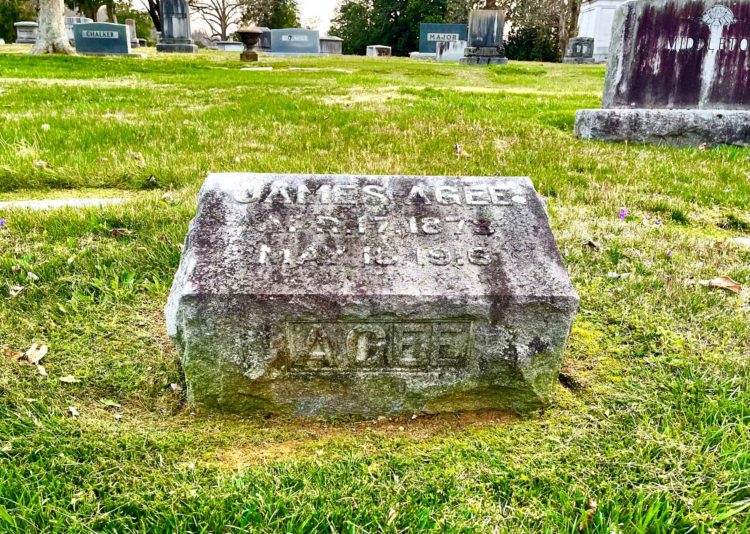What all did they do out there? They put him down in the ground and then they put all the flowers on top. Then they say their prayers and then they all come home again. In Greenwood Cemetery. He saw in his mind a clear image of Greenwood Cemetery; it was on a low hill and among many white stones there were many green trees through which the wind blew-in the sunlight, and in the middle there was a heap of flowers and beneath the flowers, in his closed coffin, looking exactly as he had looked this morning, lay his father. Only it was dark, so he could not be seen.
This passage (spoiler alert) references the funeral of the dearly departed in James Rufus Agee’s Pulitzer Prize winning novel, A Death in the Family. Young Rufus Follet is imagining the graveside service of his father, Jay, who was killed in a single vehicle crash on Ball Camp Pike at Bell’s Bridge.
How Agee (who went by Rufus) came up with the location in his work of barely fiction is lost to history. There is very little in A Death in the Family that did not come straight from young Agee’s life in Knoxville, including the death of his father. Hugh James Agee (who went by Jay) died in 1916 on the old Clinton Pike crossing Bell’s Bridge at Beaver Creek (the actual creek, not the road). Because there was indeed a Bell’s Bridge, but it was hell and gone from Ball Camp Pike.
The last home the senior Agee saw before his fatal wreck was that of Samuel Bell, a two-story, white clapboard farmhouse that sat on Clinton Highway near Emory Road for decades until it was torn down in the mid-90s. The house sat about 400 feet from the bridge. The accident happened on May 18, 1916.
In Rufus, James Agee in Tennessee (University of Tennessee Press, 2018), Paul F. Brown writes Bell’s daughter was home that fateful night:
Beulah taught school in Powell’s Station and lived with her parents. She did not see the crash and did not walk down to where it happened – which many women in those days would have considered improper. But she did remember people visiting the house that night and the next day, talking about the wreck and how sad it was the man died so young. “He was a healthy, handsome man, and he had a pretty wife and two little children. What a pity?”
The Agee family lived in Fort Sanders, and most of the locations noted in the novel are in that area and downtown. Much bemoaned and duly noted by local historian Jack Neely and musician/poet R.B. Morris, there is little to nothing left of Agee’s existence in Knoxville.
Greenwood Cemetery was practically brand new when Jay Agee was buried there in 1916. Perhaps there is something poetic about the one concrete tie to the younger Agee’s life being the marker on his father’s grave in Fountain City. After all, it commemorates the life and the moment that inspired his greatest work.
By some chance, here they are, all on this earth; and who shall ever tell the sorrow of being on this earth, lying, on quilts, on the grass, in a summer evening, among the sounds of the night. May God bless my people, my uncle, my aunt, my mother, my good father, oh, remember them kindly in their time of trouble; and in the hour of their taking away. – Knoxville, Summer 1915 by James Agee
Beth Kinnane is the community news editor for KnoxTNToday.com.



